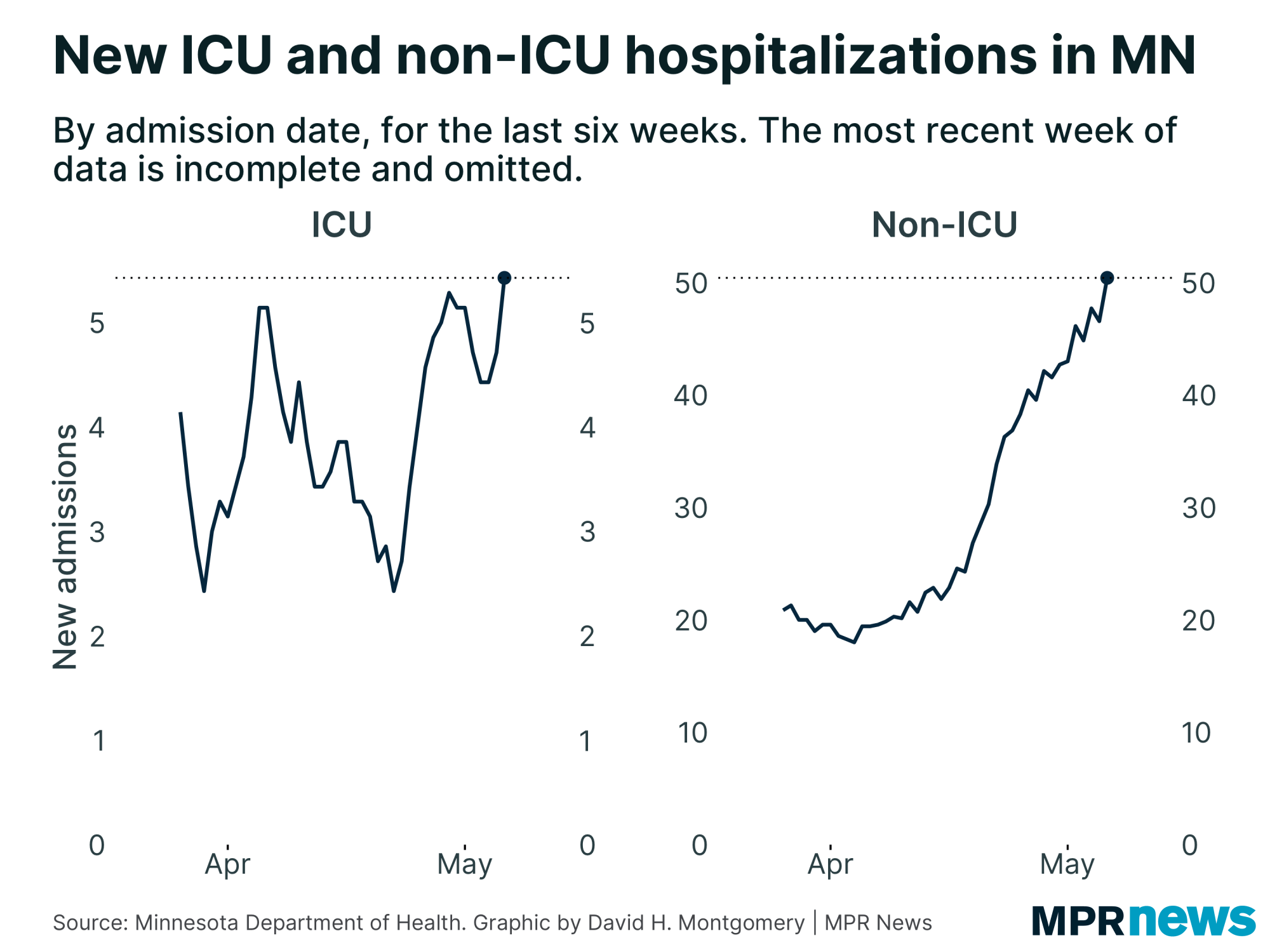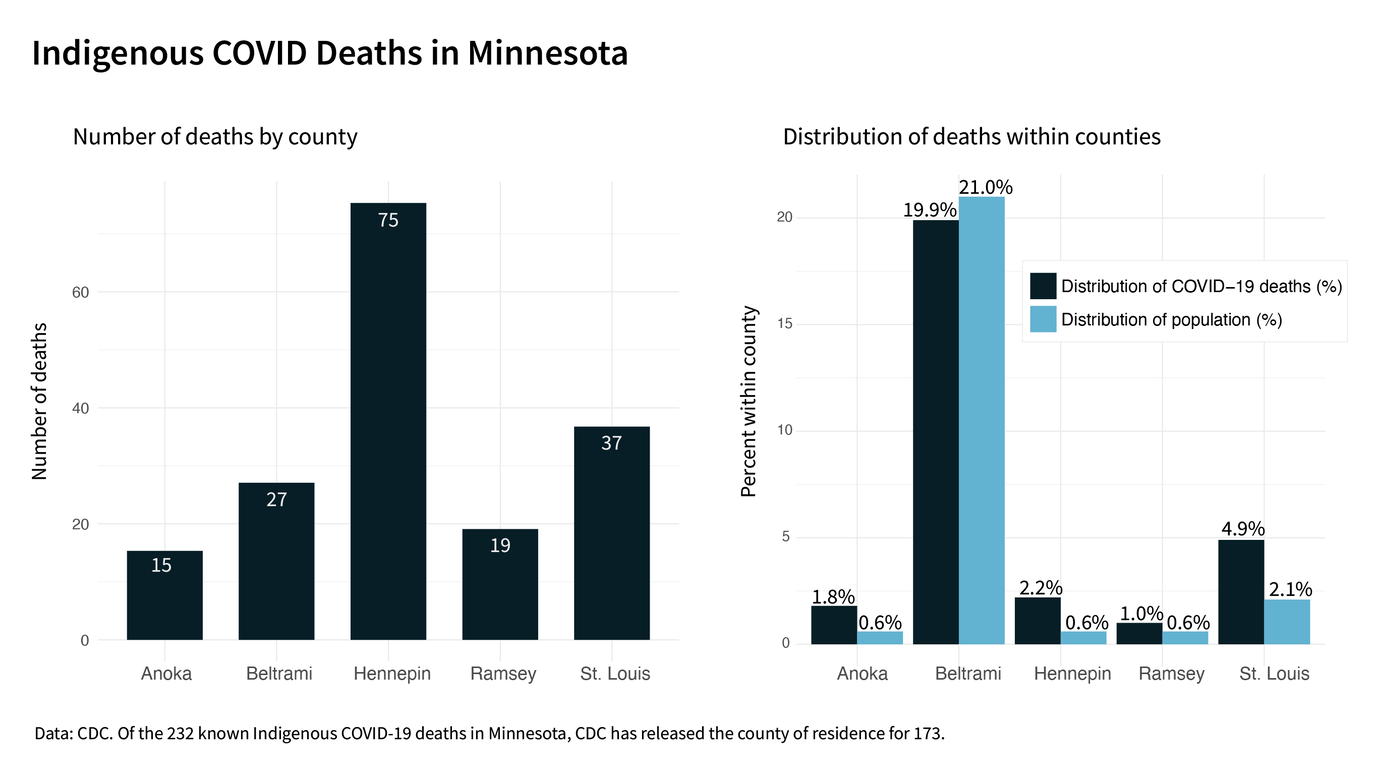United States marks 1 million COVID deaths, 12,550 in Minnesota

Go Deeper.
Create an account or log in to save stories.
Like this?
Thanks for liking this story! We have added it to a list of your favorite stories.
Yesterday President Biden paused to mark 1 million COVID-19 deaths nationwide since the start of the pandemic.
This includes over 12,550 here in Minnesota.
APM Research Lab’s Color of Coronavirus project shows that Indigenous Americans have been hit especially hard throughout the pandemic, so this week’s update concludes with a brief focus on Indigenous deaths due to COVID-19 in Minnesota.
Minnesota continues to make its way through a spring COVID-19 wave characterized by increasing case counts and hospitalizations, but - as of yet - relatively low ICU cases and new deaths.
Turn Up Your Support
MPR News helps you turn down the noise and build shared understanding. Turn up your support for this public resource and keep trusted journalism accessible to all.
Three things to know
CDC has placed nine counties in the high risk category, recommending indoor masking.
Hospitalizations and deaths continue to slowly climb, but increases in case counts might be slowing down in some parts of the state.
Wastewater shows big increases over the past month, but a possible slowing in the most recent week.
Risk assessment: CDC maps turning red, hospitalizations continue slow rise, slight upward trend in deaths
Despite many cases going unreported due to at-home testing and asymptomatic cases, official reported case counts generally continue to rise, although at a slower pace than in recent weeks. Northeastern Minnesota is an exception – it has had a particularly sharp increase in case counts the last few days.


The latest CDC indices warn of increased levels of COVID in Minnesota. Last week, the CDC's more official risk index, called COVID-19 community levels, indicated just one county, Pennington, in the high risk zone. Now there are nine counties that meet that threshold. Seven of those are in southeastern Minnesota (Rice, Dodge, Wabasha, Olmsted, Winona, Filmore and Houston), along with two at the northern edge of the state (Roseau and Lake of the Woods).
Among other precautions, the CDC recommends that residents of high risk counties should wear a mask indoors, including in K-12 schools. (You can read about the CDC's recommendations based on your county's assessment here.)
The other community risk measure from CDC, called community transmission, also points to increasing risk. Last week there were 53 counties in Minnesota with high community transmission. That number is now up to 74.
Hospitalizations are also still increasing, but not as fast as they were a few weeks ago and are still overall relatively low. ICU admissions made a small jump from averaging just above two admissions per day in late April, but have since been bouncing around five admissions per day.
Non-ICU admissions have similarly slowed their increase, but they continue to rise and it's too soon to tell if they are leveling off. The latest non-ICU admissions are sitting at about 50 per day – about a quarter of the admission rate seen during the omicron peak earlier this year.

On May 2 and 3, the 7-day averages of COVID deaths were the lowest they've been -- at 1.14 deaths per day -- since mid-July 2021. Those 7-day averages have since increased to about 3.7 per day in recent days – a number that’s likely to rise, as reporting of deaths is more lagged than other data.

Wastewater offers glimmer of hope (or is it a mirage?)
With the more limited reporting of cases, we continue to look to wastewater for more clues on the trajectory of the virus in our state. The latest regional wastewater analysis from the University of Minnesota shows a significant increase in COVID-19 across most regions over the last month, and potential signs of slowing over the last week.
The largest increases in the last four weeks were in the Twin Cities metro and southwestern Minnesota, with COVID-19 loads approaching a 600 percent increase in those areas.
Mary Koppel, the spokesperson for the project at the University of Minnesota Medical School, cautioned against reading too much into the trends over the most recent week. She also noted that the school's clinics are receiving a rush of requests for antivirals, suggesting that cases are widespread and not necessarily slowing.
And yet, the other source of wastewater COVID data also indicates a potential slowdown in cases. The Metropolitan Council’s data, released today and covering the Twin Cities, shows that after a recent peak of about 325M copies per person on May 4, the COVID load over the following 5 days was mostly in the range of 230-240M.

Omicron's BA.2 variant now accounts for 95 percent of the samples in the Twin Cities wastewater analysis. So if you do happen to catch the virus right now, chances are it's the omicron variant. And if it's possible to have a silver lining of getting omicron, research out this week shows that if you're also vaccinated, you'll now have antibodies that will better protect you against the delta variant too.
The Met Council is also now releasing the data for how much of the extremely contagious BA.2.12.1 subvariant is present, and right now it’s about 61 percent of the BA.2 share, or about 36 percent of the total load.
Many Indigenous COVID-19 deaths have been in Twin Cities
This week, the APM Research Lab released the latest update to our Color of Coronavirus project, which tracks the race and ethnicity of COVID-19 deaths. This update now includes updated state-level specific to the first quarter or 2022.

As we reported based on preliminary data a few weeks ago, COVID mortality for Indigenous Minnesotans has increased more dramatically than for other groups in recent months.
CDC also releases county-level COVID mortality data by race. This has the potential to help understand more specifically which groups in which places are facing the worse COVID outcomes.
But the data has somewhat limited use because CDC only releases mortality rates for groups and locations with at least 10 deaths. So in lower-population counties and for groups with lower overall populations, the data is less complete.
Here’s what we do know about where Indigenous deaths are occurring the most in Minnesota. Of the 232 known Indigenous deaths in the state, CDC has released the county of residence for 173. Ninety-four of those deaths were in the Twin Cities. Fifteen were in Anoka County, and 27 and 37 were in Beltrami and St. Louis counties, respectively.
Of the five counties reporting data, the biggest disparity between the percent of deaths and the percent of population of Indigenous people was in Hennepin County, where the percent of deaths was 3.7 times higher than the share of population.




